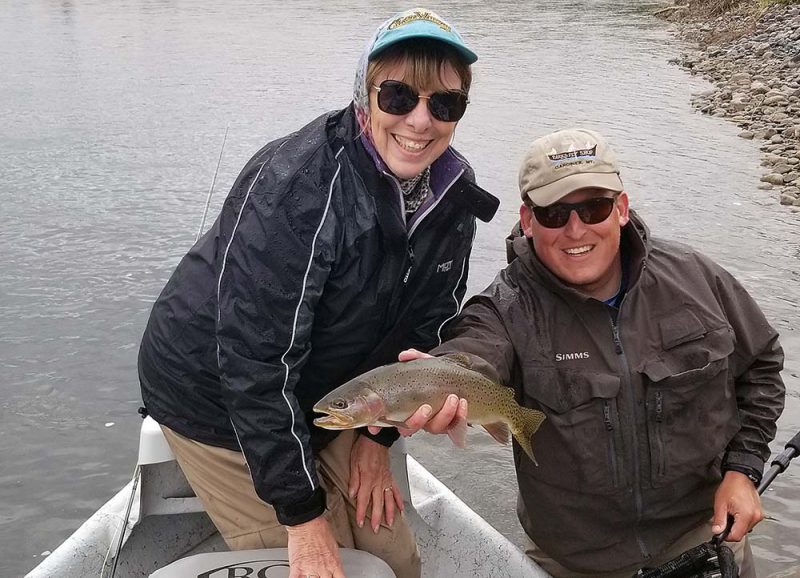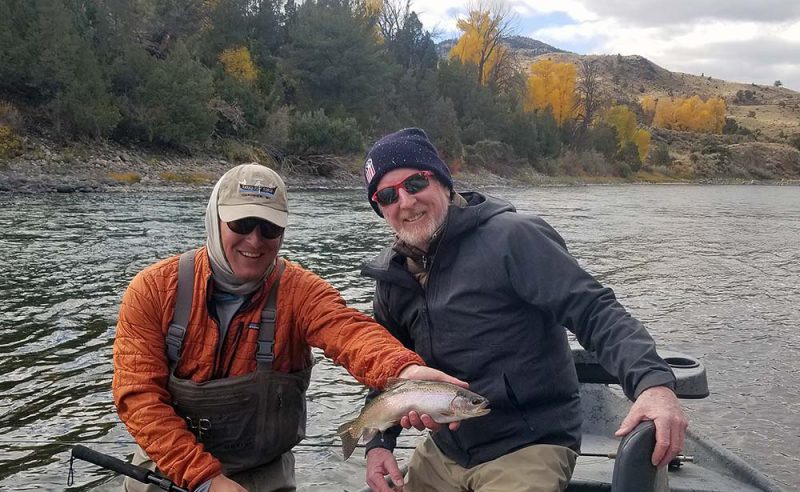Late Fall Float Trips
Posted on January 23rd, 2024 in Uncategorized
Late Fall Float Trips: Introduction
Late autumn begins when nights begin falling below freezing most nights rather than just occasionally and the first snow that doesn’t all melt by midafternoon starts to fall now and again. Most years, the first week of October is when this occurs.
After the switch flips there’s no reason to get out early in the morning save for hardcore anglers who want to try for one or two really big fish with streamers. The best fishing is typically from about 10:00AM through about 4:00PM. For this reason, almost all late fall trips operate as “shoulder season” 3/4-day trips, with 5–6 hours on the water.
Fishing is slow-paced at this time, with nymphs and streamers pounded in the deeper runs the most likely producers, but big numbers of rising trout also possible during good BWO hatches. This is the time of year when guides do most of their fishing. Little wonder. The big fish are eating, but there isn’t much work. Want to find out why the guides tend to like fishing during this period?

Late Fall Float Trips: Quick Facts
- Best Waters: All waters that remain high enough to float this late in the year can be excellent, but we generally stick close to home on the Yellowstone.
- Three Top Reasons to Come in Late Autumn: 1.) This is an excellent time to target big fish, 2.) Crowds are nonexistent, and 3.) the dry fly fishing can still be good for a couple hours each afternoon, and it’s generally much better than early spring.
- Three Top Reasons to Avoid Late Autumn: 1.) Weather and water conditions are wildly inconsistent and can be miserable: it can snow feet and remain below freezing for days at a time, or be too warm and bright. 2.) The numbers of fish caught on an average day are far lower than in summer, and 3.) Morning fishing is very slow most days.
- Perfect Clients: Experienced anglers who want to fish nymphs and streamers for larger fish, with a solid chance of some good dry fly fishing many afternoons.
- What Late Autumn Does Best: Produces big browns on their spawning runs and the rainbows that follow them looking for a meal of eggs.
Late Fall Float Trips: The Details
Things fall apart in late fall (October and early November), but they fall apart in a delightful way. With the possible exception early spring, this is the best big fish period of the season on float trips, and since the early autumn hatches continue to a degree, this is still an okay time for solid numbers of trout on dry flies as well.
The top rivers at this time are the Yellowstone, the lower Madison, the Missouri near Holter Dam, and the lower Gallatin, Jefferson, and the Missouri River headwaters (these last three waters only for those wanting one or two monster trout). We spend most of our personal and guiding time on the Yellowstone.

Most fishing during this period is subsurface, with streamers producing the largest fish and midge pupae, BWO nymphs, and egg imitations producing the numbers. BWO hatches continue and can produce good dry fly fishing for an hour or two in the afternoons and the fish willing to eat the nymphal forms of these bugs much of the rest of the time. The main driver of the fishing at this time isn’t bugs, however. It’s the upcoming or underway brown trout spawn.
In early October, the big browns are migrating to spawning areas and feeling aggressive, making streamers targeting these fish the best tactic.
In late October and early November, the browns are in the midst of their spawn. We do not target actively spawning wild trout on any of our trips, but the non-spawning rainbows, cutthroats, and even non-spawning or pre-spawn browns that hang below their cousins chomping eggs are fair game. Egg imitations are the best flies for these fish, but they’re frequently quite aggressive to a variety of flies, including dead-drifted streamers and mayfly nymphs as well as eggs.
Weather and water conditions can be rather… burly… at this point in the year. Early cold snaps in particular can make both the fishing and just being on the water a challenge. Ideal conditions see air temperatures between 45 and 55 degrees with cloud cover, drizzle, and occasional flurries. Let that sink in. Gross and uncomfortable weather produces the best fishing. The bright, sunny, warm, Indian summer sort of days most people love to see in October are poor for angling at this time. “Winter in October” is also bad, but it does require seriously ugly weather for us to consider canceling: temperatures below freezing, with wind and precipitation. Bear that in mind before booking a float for this period.

There’s almost never any reason to get out early during this period, particularly after the middle of October. We mostly run half-day trips meeting around 10:30AM.
Late fall floats are better for experienced anglers who know what they’re getting into in terms of the weather, but particularly early in this period they’re still good bets for beginners, and they’re not poor choices for rookies right up until it gets too cold to want to float for the rest of the year. This is because nymph tactics in slow-moving water are often the best tactic for numbers of trout, often with the boat stopped in likely areas. This give beginners plenty of second chances to get the casts and drifts right and will not overwhelm them.
This is a poor time for young kids, since they often get cold/wet/miserable given the “standard” fall weather.
Our float season concludes sometime in early November when it gets too cold to make these trips feasible.
>>>>>>>>>> Back to Float Trips Page
